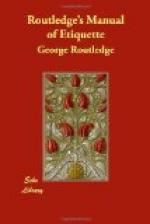The bride and bridegroom sit together at the centre of the table, in front of the wedding cake, the clergyman who performed the ceremony taking his place opposite to them. The top and bottom of the table are occupied by the father and mother of the bride. The principal bridesmaid sits to the left of the bride, and the principal bridegroomsman on the left of the bridegroom. It may not be unnecessary to say that it is customary for the ladies to wear their bonnets just as they came from the church. The bridesmaids cut the cake into small pieces, which are not eaten until the health of the bride is proposed. This is usually done by the officiating clergyman, or by an old and cherished friend of the family of the bridegroom. The bridegroom returns thanks for the bride and for himself. The health of the bride’s parents is then proposed, and is followed by those of the principal personages present, the toast of the bridesmaids being generally one of the pleasantest features of the festal ceremony. After about two hours, the principal bridesmaid leads the bride out of the room as quietly as possible, so as not to disturb the party or attract attention. Shortly after—it may be in about ten minutes—the absence of the bride being noticed, the rest of the ladies retire. Then it is that the bridegroom has a few melancholy moments to bid adieu to his bachelor friends, and he then generally receives some hints on the subject in a short address from one of them, to which he is of course expected to respond. He then withdraws for a few moments, and returns after having made a slight addition to his toilet, in readiness for travelling.
In some recent fashionable weddings we have noticed that the bride and bridegroom do not attend the wedding breakfast, but after a slight refreshment in a private apartment, take their departure immediately on the wedding tour. But this defalcation, if we may so call it, of the chief dramatis personae of the day, though considered to be in good taste, is by no means a popular innovation, but is rather regarded as a prudish dereliction from the ancient forms of hospitality, which are more prized than ever on so genial an occasion as a marriage.
Departure for the Honeymoon.
The young bride, divested of her bridal attire, and quietly costumed for the journey, now bids farewell to her bridesmaids and lady friends. A few tears spring to her gentle eyes as she takes a last look at the home she is now leaving. The servants venture to crowd about her with their humble but heartfelt congratulations; finally, she falls weeping on her mother’s bosom. A short cough is heard, as of some one summoning up resolution to hide emotion. It is her father. He dares not trust his voice; but holds out his hand, gives her an affectionate kiss, and then leads her, half turning back, down the stairs and through the hall, to the door, where he delivers her as a precious charge to her husband, who hands her quickly into the carriage, springs in after her, waves his hand to the party who appear crowding at the windows, half smiles at the throng about the door, then, amidst a shower of old slippers—missiles of good-luck sent flying after the happy pair—gives the word, and they are off, and started on the long-hoped-for voyage!




